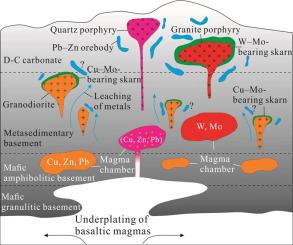当前位置:
X-MOL 学术
›
Ore Geol. Rev.
›
论文详情
Our official English website, www.x-mol.net, welcomes your
feedback! (Note: you will need to create a separate account there.)
Accumulation of sulfides in the basement of southern Hunan Province, China: implications for Pb–Zn mineralization related to reduced granitoids
Ore Geology Reviews ( IF 3.2 ) Pub Date : 2021-02-01 , DOI: 10.1016/j.oregeorev.2020.103939 Teng Ding , Jia Wang , Tingting Tan , Dongsheng Ma , Jianjun Lu , Rongqing Zhang , Jin Liang , Chuanwei Zhu , Bin Wu
Ore Geology Reviews ( IF 3.2 ) Pub Date : 2021-02-01 , DOI: 10.1016/j.oregeorev.2020.103939 Teng Ding , Jia Wang , Tingting Tan , Dongsheng Ma , Jianjun Lu , Rongqing Zhang , Jin Liang , Chuanwei Zhu , Bin Wu

|
Abstract Southern Hunan Province lies at the intersection of the Shi–Hang zone and Nanling belt, and is characterized by extensive Mesozoic igneous rocks and coeval polymetallic deposits, including early granodiorite porphyry-related Cu–Pb–Zn polymetallic mineralization (ca. 160 Ma) and late granite-related W–Sn polymetallic mineralization (ca. 155 Ma). Amongst these deposits, the Huangshaping deposit is unique for the coexistence of economic W–Mo and Pb–Zn mineralization, which is associated with reduced granitoids, including quartz porphyry, felsite, and granite porphyry. Unlike the W–Mo mineralization, which has a close temporal–spatial relationship with granite porphyry, the sources of Pb–Zn mineralization have not yet been clarified, mainly because of its distal orebodies of unknown age. Abundant granodioritic enclaves have recently been found in quartz porphyry of the Huangshaping deposit, with zircon U–Pb ages consistent with the quartz porphyry and containing abundant sulfides including chalcopyrite, sphalerite, and pyrrhotite. This study involved in situ LA–ICP–MS determinations of trace element compositions of these sulfides, for comparison with those of sulfides in distal ores and carbonate strata to elucidate the sources of Pb–Zn mineralization in this deposit. Sulfides from granodioritic enclaves have higher Co/Ni ratios, but similar Zn/Cd, Cu/In, and Pb/Sb ratios, compared with those of distal Pb–Zn ores, indicating that sulfides in both enclaves and ores were precipitated from hydrothermal fluids derived from the same single source, although with higher precipitation temperatures for the former. As sulfides in the ores have Pb isotopic compositions distinct from those of other granitoids, we suggest that intrusion of the granodiorites (∼5 Myrs before the granitoids) resulted in the accumulation of ore-forming metals in the metamorphic or crystalline basement. These metals were then scavenged by hydrothermal circulation triggered by later intrusions of felsite and granite porphyry, especially fluorine-rich granite porphyry, forming the distal Pb–Zn mineralization near the surface of the deposit. The accumulation of sulfides triggered by earlier granodioritic activity was likely crucial for the formation of distal sulfide mineralization, and perhaps also for that in other W–Mo deposits related to reduced granites in southern Hunan Province.
更新日期:2021-02-01











































 京公网安备 11010802027423号
京公网安备 11010802027423号